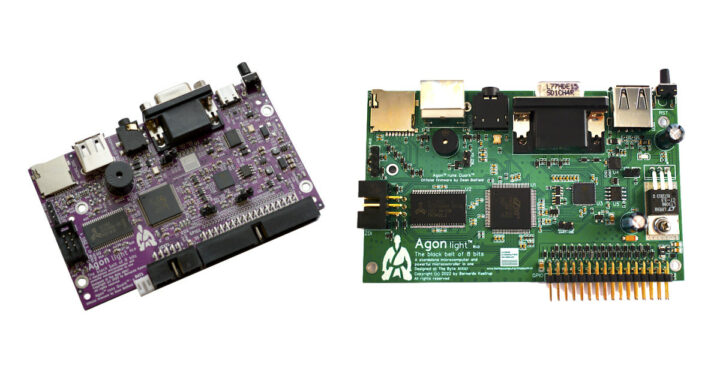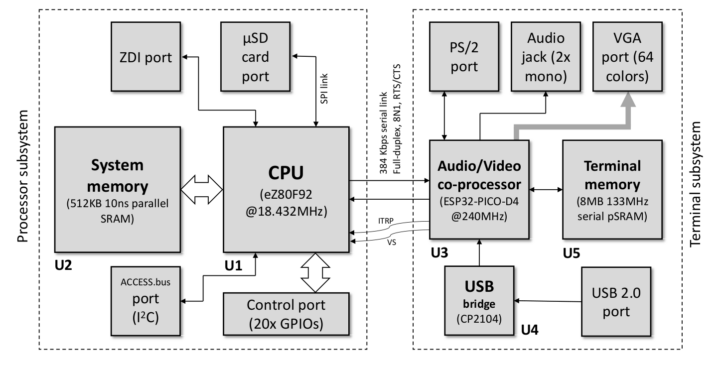Olimex has started to take pre-orders for the AgonLight2, a customized version of the Agon Light 8-bit open-source hardware computer based on the Z80 family and running BBC Basic.
Bernardo Kastrup and Dean Belfield created the Agon light 8-bit retro computer with VGA and PS2 keyboard port and programmable with BASIC earlier this year and released all hardware design files, the firmware, and documentation on GitHub, and Dean uploaded a one-hour-long video on YouTube. It was designed with EasyEDA, but Olimex re-captured the design in KiCad after getting customer requests, and the new cost-optimized board named AgonLight2 will start shipping by the end of January 2023.

AgonLight2 specifications:
- MCU – Zilog eZ80F92 8-bit microcontroller @ 18.423 MHz with 128 KB flash, 256 bytes conguration Flash memory, 8 KB SRAM (See PDF datasheet for details)
- System Memory – 512KB, 10ns, parallel SRAM
- Storage – MicroSD card socket
- Terminal subsystem
- MCU – ESP32-PICO-D4 dual-core SiP @ up to 240 MHz with 4MB flash
- Memory – 8MB, 133 MHz, serial PSRAM
- Video Output – VGA port up to 640×480 resolution, 64 colors
- Audio – 2x mono audio jacks
- USB 2.0 Type-C port for power and programming ESP32’s firmware
- USB Type-A port for keyboard
- Programming – ZDI port for programming the firmware of the CPU
- Expansions
- Plastic boxed control port with 20 GPIOs
- UEXT expansion board for Olimex add-on modules
- Power Supply
- 5V via USB Type-C port or control port; DCDC converter (up to 2A)
- LiPo battery support with charging circuit, 2-pin connector, and Vbat on control port
- Dimensions – TBD

The main changes made by Olimex are highlighted in bold in the specs above, but I’ll list them again for more clarity:
- Replaced the USB-A power connector with a USB-C connector as it is used in all new phones, tablets and devices as mandated by a new EU directive
- Replaced the PS2 connector with a USB-A connector for connecting USB keyboards without an adapter
- The Linear voltage regulator was replaced with a DCDC converted which delivers up to 2A current
- Added support for LiPo batteries
- Replaced the bare header 32-pin connector with a plastic boxed 34-pin connector, adding two additional signals Vbat and Vin which allow AgonLight to be powered by this connector too.
- Added a UEXT connector for Olimex modules
- A few other small changes and most of the components were changed to Olimex’s component base to lower costs
The new AgonLight2 supports the same Quark firmware as the Agon light with three modules: Quark BBC BASIC, Quark MOS, and Quark VDP which can be found in the GitHub repo linked in the introduction. Olimex talked with Bernardo to make sure it was a truly open-source hardware project before, and the updated board is now even featured on the official project’s page. The KiCad hardware design files and datasheets for the AgonLight2 board can be found on GitHub.
Olimex is taking pre-orders for 50 Euros for the AgonLight2, which looks like a pretty good price considering the Agon Light board had an estimated BoM cost of around $50 for a small production run. Shipping is expected to start on January 31, 2023.

Jean-Luc started CNX Software in 2010 as a part-time endeavor, before quitting his job as a software engineering manager, and starting to write daily news, and reviews full time later in 2011.
Support CNX Software! Donate via cryptocurrencies, become a Patron on Patreon, or purchase goods on Amazon or Aliexpress. We also use affiliate links in articles to earn commissions if you make a purchase after clicking on those links.




What’s needed is a low cost battery handheld gaming device based on this CPU. To be used for retro Z80 Gaming.
Kind of disagree. The MCU is very slow. For handheld gaming device emulator probably could be better if something like Bouffalo Lab BL808 is used.
This looks like it’ll be cheaper than the BL808,.. has two Cortex A7s that run at ~1.3GHz, 2D hardware.
2x Tensilica LX6 @ 240Mhz, not
Cortex A7, but this is one is more for retrocomputing enthusiasts, like so called “fantasy consoles” do. Nice device in this way, even if BL808 is really far more powerful.So what’s old is new again! Remember the Intel 8052AH-BASIC chip from around 1985? It was an 8-bit 8052AH microcontroller in a 40-pin plastic DIP package with a complete full-featured MCS BASIC-52 interpreter resident in the 8KB of on-chip ROM.[1] Home-made wire-wrapped 8052AH-BASIC single-board computers using a surplus Teletype Model 33 ASR (Automatic Send and Receive) teleprinter (or similar) with a built-in eight-hole punched tape reader/punch as the user console were popular.[2] The standard Teletype Model 33 ASR would operate at typically 60 or 100 words per minute (WPM, gear-set) using an upper-case only version of the CCITT International Telegraphic Alphabet No. 5 (now ITU-T-REC-T.50 [3][4]), with one (even) parity bit and two stop bits. Program storage was accomplished on loops of messy pre-lubricated punched paper-tape. Teletype Model 33 machines were interfaced via an RS-232 or 20mA current-loop serial interface.
* References:
1. Original Intel 8052AH-BASIC Data Sheet [.pdf]
https://www.datasheetarchive.com/8052ah%20basic-datasheet.html
2. Teletype Model 33
https://en.wikipedia.org/wiki/Teletype_Model_33
3. 06 What is the International Alphabet No. 5?
https://blog.gcwizard.net/manual/en/ccitt-codes/06-what-is-the-international-alphabet-no-5/
4. T.50 : International Reference Alphabet (IRA) (Formerly International Alphabet No. 5 or IA5)
https://www.itu.int/rec/T-REC-T.50
I believe the GPIOs are still on male headers, they just have a palstic shroud around them (similarly to the UEXT connector on the board).
Doesn’t the directive apply only to mobile phones, tablets, consoles and the likes in 2024 and laptops in 2026? The battery in this thing is optional, so I’m not sure if it would even fall under the scope of the directive.
You may be right. Maybe I misunderstood the text in Olimex’s blog:
So I’ve change the text a bit.
WTF? Use a more powerful processor as a I/O processor for an 8-bit processor!?
Not quite, that 20MHz eZ80 is more comparable to being 160-240MHz Z80, so leaving I/O acceleration to high-level-only LX6s, while being able to code application code in well-known pure Z80 assembly is not bad of a concept.